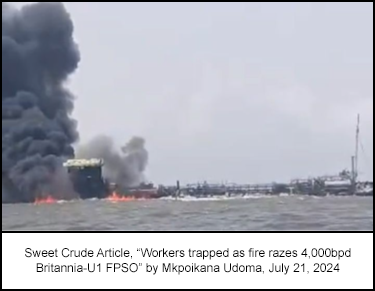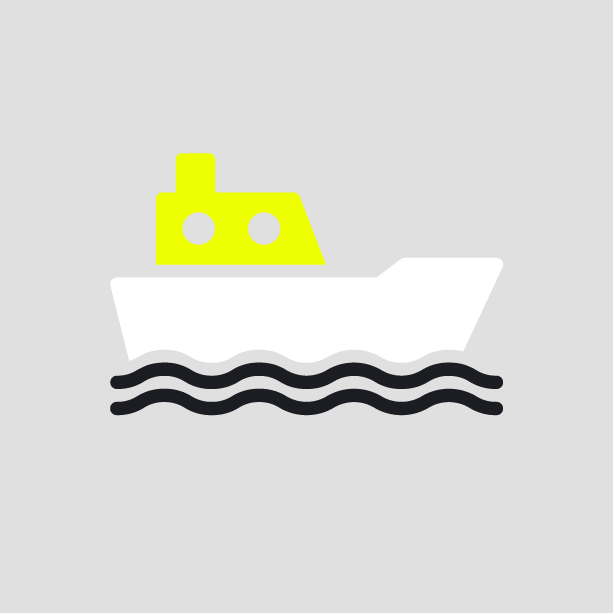-
What happened?
A fire occurred on a floating production storage and offloading (FPSO) facility offshore.
It was reported that this incident resulted in significant asset damage and abandonment of the facility; however, all crew members were rescued.

-
Why did it happen?
Marine fire risk is a persistent challenge within the industry. For example:
- International Marine Contractors Association (IMCA) published a report in March 2024 (https://www.imca-int.com/resources/technical-library/document/4216b95b-c55b-ee11-8def-6045bdd2cf5f/) highlighting information on marine fires to reflect the latest statistics and industry developments.
- IMCA published on 22 May 2024, a safety flash (https://www.imca-int.com/resources/safety/safety-flashes/1024-engine-failure-and-subsequent-engine-room-fire/) on an engine room fire incident caused by catastrophic diesel generator failure.
The two most common causes of marine fires:
- Most frequent: Loss of hydrocarbon containment in machinery space.
- Second most frequent: Electrical fault / short.
The American Bureau of Shipping first published the Guide for Enhanced Fire Protection Arrangements (https://ww2.eagle.org/content/dam/eagle/rules-and-guides/current/other/202-enfireprotection-2022/efp-guide-july22.pdf) to help owners reduce marine fire risks and there have been multiple updated revisions subsequently published with the latest in 2022.

-
What did they learn?
There is frequently no mandate for existing facilities to comply with new marine classification society (i.e., facilities may be grandfathered).
There are various preventative safeguards to avoid loss of hydrocarbon containment initiating a machinery space fire such as:
- Flange spray shields.
- Use of metallic hoses in hydrocarbon system.
- Operator early identification of deterioration / leaks prior to ignition.
There are various best practices to prevent electrical fires such as performing annual thermographic inspections to detect overheating components.
It is important to ensure operator familiarity with incident response procedures, and periodic drills are performed for different fire scenarios and locations including:
- Living quarters.
- Upper deck.
- Machinery space and pump room (if applicable).

-
Ask yourself or your crew
Are individuals aware of marine specific fire risks and current recommended engineering / administrative safeguards?
Considering the expectations outlined in applicable standards, processes, and procedures: are existing safeguards effective to mitigate known marine fire risks? How do we know?
As new risk mitigation best practices are identified, how are these assessed for potential voluntary adoption if not mandated for existing facilities?

Add to homescreen
Content name
Select existing category:
Content name
New collection
Edit collection
What happened?
A fire occurred on a floating production storage and offloading (FPSO) facility offshore.
It was reported that this incident resulted in significant asset damage and abandonment of the facility; however, all crew members were rescued.

Why did it happen?
Marine fire risk is a persistent challenge within the industry. For example:
- International Marine Contractors Association (IMCA) published a report in March 2024 (https://www.imca-int.com/resources/technical-library/document/4216b95b-c55b-ee11-8def-6045bdd2cf5f/) highlighting information on marine fires to reflect the latest statistics and industry developments.
- IMCA published on 22 May 2024, a safety flash (https://www.imca-int.com/resources/safety/safety-flashes/1024-engine-failure-and-subsequent-engine-room-fire/) on an engine room fire incident caused by catastrophic diesel generator failure.
The two most common causes of marine fires:
- Most frequent: Loss of hydrocarbon containment in machinery space.
- Second most frequent: Electrical fault / short.
The American Bureau of Shipping first published the Guide for Enhanced Fire Protection Arrangements (https://ww2.eagle.org/content/dam/eagle/rules-and-guides/current/other/202-enfireprotection-2022/efp-guide-july22.pdf) to help owners reduce marine fire risks and there have been multiple updated revisions subsequently published with the latest in 2022.
What did they learn?
There is frequently no mandate for existing facilities to comply with new marine classification society (i.e., facilities may be grandfathered).
There are various preventative safeguards to avoid loss of hydrocarbon containment initiating a machinery space fire such as:
- Flange spray shields.
- Use of metallic hoses in hydrocarbon system.
- Operator early identification of deterioration / leaks prior to ignition.
There are various best practices to prevent electrical fires such as performing annual thermographic inspections to detect overheating components.
It is important to ensure operator familiarity with incident response procedures, and periodic drills are performed for different fire scenarios and locations including:
- Living quarters.
- Upper deck.
- Machinery space and pump room (if applicable).
Ask yourself or your crew
Are individuals aware of marine specific fire risks and current recommended engineering / administrative safeguards?
Considering the expectations outlined in applicable standards, processes, and procedures: are existing safeguards effective to mitigate known marine fire risks? How do we know?
As new risk mitigation best practices are identified, how are these assessed for potential voluntary adoption if not mandated for existing facilities?
A fire occurred on a floating production storage and offloading (FPSO) facility offshore. It was reported that this incident resulted in significant asset damage and abandonment of the facility; however, all crew members were rescued.










